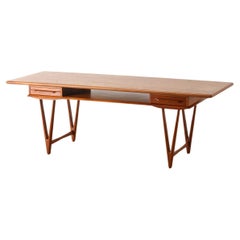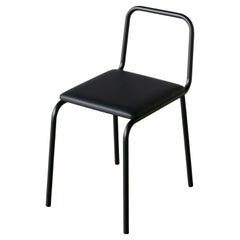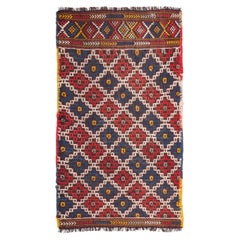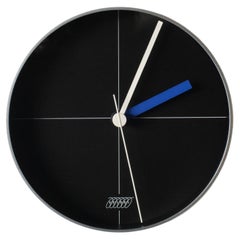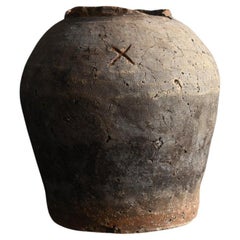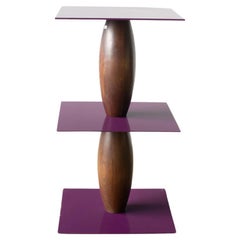Japan - Furniture
to
548
508,946
446,290
1,987
1,325
26
187
137
109
10
8
4
3
3
2
2
1
1
138
384
1,465
1,351
459
517
271
7
8
13
22
26
107
112
84
76
23
1,117
831
785
763
762
2,744
1,928
1,890
707
706
3,338
3,245
3,279
289
58
41
34
33
Item Ships From: Japan
E.W. Bach Coffee Table Model.32 1960's
By E.W. Bach
Located in Shibuya-ku, 13
This stunning vintage coffee table was designed by renowned Danish designer E.W. Bach, a celebrated figure in mid-century Scandinavian furniture design.
Crafted from high-quality tea...
Category
1960s Danish Mid-Century Modern Vintage Japan - Furniture
Materials
Teak
Comme Des Garçons No.7 Chair Rei Kawakubo
By Comme des Garçons, Rei Kawakubo
Located in Shibuya-ku, Tokyo
Comme des garçons no.7 chair.
Iconic CDG chair designed by Rei Kawakubo in the 80s. This black model is produced in 2019 for Comme des Garcons special event.
Condition is never use...
Category
1980s Japanese Minimalist Vintage Japan - Furniture
Materials
Steel
Adana Cecim Jejim Cicim Small Kilim Southern Anatolian Carpet Turkish Yastık Rug
Located in Tokyo, JP
This is a traditional handwoven kilim from the Adana region in southern Türkiye. Measuring 57 cm x 96 cm, it is made from 100% wool. Originally, this piece was used as the front pane...
Category
Late 20th Century Turkish Kilim Japan - Furniture
Materials
Wool, Natural Fiber
$384 Sale Price
20% Off
Spiral Clock B #3 Silver Body Shiro Kuramata Japanese Zen
By Shiro Kuramata
Located in Shibuya-ku, Tokyo
Spiral clock B #3 silver body designed by Shiro Kuramata. Dial is inside acrylic edge rounded shade.
Black body model is also available.
Category
1980s Japanese Minimalist Vintage Japan - Furniture
Materials
Steel
Small antique Japanese pottery vase/14th to 15th century/"Shigaraki ware"
Located in Sammu-shi, Chiba
It is "Shigaraki ware".
Shigaraki is a historical kiln located in Shiga Prefecture, Japan. (Shigaraki Kiln is marked with a red circle on the map.)
It is said to have originated in t...
Category
15th Century and Earlier Japanese Other Antique Japan - Furniture
Materials
Pottery
Marco Zanini Zanzibar side table violet
By Marco Zanini, Bieffeplast
Located in Shibuya-ku, Tokyo
Zanzibar side table designed by Marco Zanini for Bieffeplast. Marco Zanini designed 12 side tables for Bieffeplast around the late 80s. This is one of 12 varietions that Bieffeplast ...
Category
1980s Italian Post-Modern Vintage Japan - Furniture
Materials
Steel
$2,200 / item
1610-1640/Japanese White Porcelain Blue and White Vase/"Imari Ware"/Sake Bottle
Located in Sammu-shi, Chiba
I bought a very nice vase with white porcelain and blue dye.
This is a sake bottle called Imari ware in Japan.
Imari ware is a kiln with a long history that began in the 17th cen...
Category
Early 17th Century Japanese Edo Antique Japan - Furniture
Materials
Porcelain
Ararat Rugs Konagkend Kuba Rug, Antique Caucasian Revival Carpet, Natural Dyed
By Ararat Rugs
Located in Tokyo, JP
The source of the rug comes from the book Oriental Rugs Volume 1 Caucasian, Ian Bennett, Oriental Textile Press, Aberdeen 1993, nr.332. This is a sp...
Category
21st Century and Contemporary Turkish Revival Japan - Furniture
Materials
Wool, Natural Fiber, Organic Material
Vintage & Old Kilim Cushion Cover, Anatolian Yastik Turkish Modern Pillow 4445
Located in Tokyo, JP
We made a cushion cover using the undamaged parts of the precious and high-quality old & antique kilims that cannot be repaired. Like a painting, a part of the scenery is cut out fro...
Category
2010s Turkish Kilim Japan - Furniture
Materials
Natural Fiber, Organic Material
$120 Sale Price
20% Off
Japanese Antique Black folding table, Wabi-sabi, Japandi
Located in Katori-Shi, 12
A folding table made in the Taisho era.
The lacquered cherry wood has a timeless, high-quality texture and a delicate look that is not too sweet.
Its soft appearance blends gently ...
Category
Early 20th Century Japanese Taisho Japan - Furniture
Materials
Wood
Edo Period (19th) Japanese antique painting of flowers
Located in Fukuoka, JP
Japanese antique painting of flowers 19 C
Weight 3kg ( 6.6lb)
Category
Mid-19th Century Japanese Edo Antique Japan - Furniture
Materials
Silk, Paper
Ararat Rugs Fachralo Kazak Rug 19th Century Caucasus Revival Carpet Natural Dyed
By Ararat Rugs
Located in Tokyo, JP
This is another Kazak example of the Fachralo a town north of Lori-Pambak and just southwest of Bordjalou, from the late 19th century, Caucasus area. It has given its name to a number of usually small, boldly designed, and brilliantly colored Kazak rugs but, although this has proved a useful descriptive adjective in the rug trade, it is one used by experts on Caucasian weaving with caution. Modern research also favors the spelling of Fekhraly or Fachraly. Structurally, all the pieces are fairly similar. The foundation is all wool; the warp is usually ivory or ivory mixed with one or more shades of natural brown, and the wefts are one or more of various shades of orange-pink, pink or red. It is framed with a series of borders, the main of which is the typical Bordjalou style. The most appropriate colors to match the original is used for this rug.
Color summary: 6 colors of total most used 4 colors are
Charleston Green...
Category
21st Century and Contemporary Turkish Revival Japan - Furniture
Materials
Wool, Natural Fiber, Organic Material
Japanese Antique Duck Decoy 1920s-1940s / Figurine Object Wabisabi
Located in Chōsei District Nagara, JP
This is an old duck decoy made in Japan.
It is a wood carved artifact made during the Showa period (1920s-1940s).
The material is cedar wood, and the g...
Category
Mid-20th Century Japanese Showa Japan - Furniture
Materials
Cedar
Ararat Rugs Lori Pambak Kazak Rug, 19th C Caucasus Revival Carpet Natural Dyed
By Ararat Rugs
Located in Tokyo, JP
The source of the rug comes from the book Oriental Rugs Volume 1 Caucasian, Ian Bennett, Oriental Textile Press, Aberdeen 1993, pg.24. This is a medallion rug from the late 19th cent...
Category
21st Century and Contemporary Turkish Revival Japan - Furniture
Materials
Wool, Natural Fiber, Organic Material
Vintage & Old Kilim Cushion Cover, Anatolian Yastik Turkish Modern Pillow 4180
Located in Tokyo, JP
We made a cushion cover using the undamaged parts of the precious and high-quality old & antique kilims that cannot be repaired. Like a painting, a part of the scenery is cut out fro...
Category
2010s Turkish Kilim Japan - Furniture
Materials
Natural Fiber, Organic Material
$96 Sale Price
20% Off
19th century Edo-period Japanese Hanging Scroll Calligraphy of Mad Poetry
Located in Chiba, JP
Hanging scroll with such unstrained and refined calligraphy of ‘Kyoka’ (lit. ‘Mad poetry’ – Humorous style of Japanese tanka poetry with joke or irony or satire) by a late Edo-period...
Category
19th Century Japanese Edo Antique Japan - Furniture
Materials
Brocade, Wood, Paper
1860s-80s Japanese antique wabi sabi Urushi mid Tansu chest of drawers
Located in 常陸大宮市, JP
From Kanto or Tohoku area, Japan.
This mid-size, black Urushi lacquered Tansu chest of drawers is a product of late Edo to early Meiji era (circa 1860s-1880s) , estimate from the st...
Category
Late 19th Century Japanese Edo Antique Japan - Furniture
Materials
Wood
B25 Japanese Antiques CalligraphyA 6panels, Silver Paper, folding Screen
Located in Niiza, JP
Calligraphy, folding screen
Material: Paper, wooden frame
1 piece: Width 590 x Height 1700 x Depth 15 mm
Expanded size: Width 3580 mm
Folded size: Width 610 x Height 1700 x Depth 10...
Category
19th Century Japanese Antique Japan - Furniture
Materials
Paper
Old Vintage Beluch Carpet, Cental Asian Baluch Beluchi Baluchi Baluchistan Rug
Located in Tokyo, JP
This is a Central Asian Old Beluch ( also called Balouch, Balochi, Baluchi, Baluch, or Beluchi carpets) Carpet from the Baluchistan region with a rare and beautiful color composition and high-quality materials like; wool & dyes.
These carpets were woven by the nomads of the Baloch tribes. Baloch rugs...
Category
Mid-20th Century Turkmen Oushak Japan - Furniture
Materials
Wool, Natural Fiber
$2,120 Sale Price
20% Off
Mid 19th Century Framed Japanese Painting. Snail, Wasp & Hollyhock.
Located in Kyoto, JP
Obata Tosho (1812-1886)
Snail, Wasp & Hollyhock
Late Edo period, mid 19th Century
Framed Japanese Painting. Ink and color on paper.
Individually framed 19th century bird and flow...
Category
Mid-19th Century Japanese Edo Antique Japan - Furniture
Materials
Paper
Old Japanese woodblock print folding screen/room partition/object
Located in Sammu-shi, Chiba
This is a woodblock-printed folding screen made in Japan during the Showa period, featuring writings by a Chinese calligrapher.
It is a passage from a story written by a famous Chin...
Category
20th Century Japanese Showa Japan - Furniture
Materials
Paper
Old Japanese wabi-sabi wooden tray / 20th century/Tableware[obon]
Located in Sammu-shi, Chiba
This is a wooden tray made in Japan between the Taisho and early Showa periods.
In Japanese, it is called "obon."
The material is unknown, but it is thought to be wood such as horse ...
Category
20th Century Japanese Taisho Japan - Furniture
Materials
Wood
Japanese Antique Pottery Vase 1900s-1940s / Kasama
Located in Sammu-shi, Chiba
This ceramic vase was made in Kasama, Japan. Kasama is a traditional and famous pottery producing area.
It is very old vase.
It has a very beautiful light blue glaze and has a wond...
Category
Early 20th Century Japanese Taisho Japan - Furniture
Materials
Pottery
Chigiri Bench by Okurayama
By Okurayama Studio
Located in Geneve, CH
Chigiri Bench by Okurayama
One Of A Kind.
Dimensions: D 60 x W 240 x H 40 cm.
Materials: Iron and stone.
Weight: 390 kg.
The Daté Kan Stone is a rare stone that exist only in a fe...
Category
2010s Japanese Modern Japan - Furniture
Materials
Stone, Iron
$24,034 / item
Contemporary Japanese Chochin Floor Lamp Limited Edition #1 Zen Washi
By Ryosuke Harashima
Located in Shibuya-ku, Tokyo
Name: OBAKE A
Contemporary style Japanese Washi Japanese traditional paper shade floor lamp. Washi shade is famous as Isamu Noguchi Akari lightings.
Base is made of brass. Limited pattern painted model. Edition of 3+1AP
E26,27 light bulb.
Available to work with 100-250V.
Artist statement
In Japan, there is an animist belief that the soul dwells in old tools that have passed a long time and turns into spirits such as "Youkai" or "OBAKE." Its existence lurks in the darkness of everyday life, sometimes causing fear and sometimes entertaining.
This lantern is not an old tool, but it is made by the historic "Kojima Shoten", where the 10th generation are craftsmen in Kyoto. It's rare nowadays, and it's a style in which lanterns are made from bamboo bones to assembling papers and painting in one workshop and go. So, I decided to transform the polite crafted Japanese lanterns, which have been run through a traditional history, into a modern and pop style. It's not just OBAKE lurking in the darkness, but an existence who snuggles up to us as a more sophisticated being.
These one-eyed OBAKE have a meaningful look that originated in ancient Sanskrit culture. The red-eye "A [a]" is the facial expression that is the first pronunciation to make a sound in Sanskrit, which means "truth" and "spirit of inquiry" at the same time. The blue-eyed "UN [hu?]" expresses the pronunciation to close the sound, and at the same time means "wisdom" and "nirvana." There is also the idea that describing the beginning and end of the universe is represented by considering the "A" and "UN" as a pair. In Asia, it is a common sight to see a pair of guardian statues...
Category
2010s Japanese Edo Japan - Furniture
Materials
Brass
Ararat Rugs Mamluk Rug with Cusped Medallion Antique Revival Carpet Natural Dyed
By Ararat Rugs
Located in Tokyo, JP
The source of the rug comes from the David Collection, Copenhagen. This rug with the Cusped Medallion was designed in the early 16th-century rug by the Mamluk Sultanate of Cairo, Egy...
Category
21st Century and Contemporary Turkish Revival Japan - Furniture
Materials
Wool, Natural Fiber, Organic Material
Antique Adana Kilim Rug Wool Old Eastern Anatolian Turkish Carpet
Located in Tokyo, JP
This is Eastern Anatolian Antique Kilim from the Adana region with a rare and beautiful color composition.
This highly collectible antique kilim has wonderful special colors and tex...
Category
Early 20th Century Turkish Kilim Japan - Furniture
Materials
Wool, Natural Fiber
Vintage & Old Kilim Cushion Cover, Anatolian Yastik Turkish Modern Pillow 4335
Located in Tokyo, JP
We made a cushion cover using the undamaged part of the precious and high-quality old & antique kilims that cannot be repaired as a whole. Like a painting, a part of the scenery is c...
Category
2010s Turkish Kilim Japan - Furniture
Materials
Natural Fiber, Organic Material
$120 Sale Price
46% Off
Ararat Rugs Oversized Mamlouk Rug A Majestic Revival of Islamic Artistry Carpet
By Ararat Rugs
Located in Tokyo, JP
Origin and Inspiration:
The Mamlouk Rug is a contemporary masterpiece that draws its inspiration from the rich textile traditions of the Mamlouk Sultanate, which reigned over Egypt a...
Category
21st Century and Contemporary Turkish Revival Japan - Furniture
Materials
Wool, Natural Fiber, Organic Material
Japanese Silk Brocade Traditional Two-Panel Folding Screen
Located in Takarazuka, JP
Extraordinary Japanese contemporary two-panel "byobu" or folding screen featuring a lady from the Heian period court, showcased in "The Tale of Genji" by Murasaki Shikibu, widely int...
Category
21st Century and Contemporary Japanese Japan - Furniture
Materials
Silk
Wooden Display Stand, Low Table, Japanese Antique, Wabi-Sabi, Mingei
Located in Katori-Shi, 12
This is a wooden antique low table from the Meiji era.
It was used as a working table for woodworkers of the time.
It is made of high quality Japanese cherry wood.
It has a beautif...
Category
Early 20th Century Meiji Japan - Furniture
Materials
Wood
Buffet from Pastoe A’dammer, design by Aldo van den Nieuwelaar
By Aldo van den Nieuwelaar, Pastoe
Located in Tokyo, Tokyo
The A’dammer stands out as a remarkable example of furniture conceived as an artistic design object. Its signature feature is the ribbed roll shutter, which can effortlessly slide aw...
Category
Late 20th Century Dutch Japan - Furniture
Materials
Wood, Lacquer
Ararat Rugs Mamluk Wagireh Rug with Jerrehian Border Design Egypt Revival Carpet
By Ararat Rugs
Located in Tokyo, JP
The design source of the rug comes from the possession of Endre Unger, which was sold at Sotheby’s in 1992. That rug with the central star was designed in the early 16th-century rug ...
Category
21st Century and Contemporary Turkish Revival Japan - Furniture
Materials
Wool, Natural Fiber, Organic Material
Japanese Antique Wooden Board, "Abstract Sculptures", Wabi-Sabi, Mingei
Located in Katori-Shi, 12
This wooden antique board is from the Meiji period.
It is made of lauan wood.
Years of use and age have given it a beautiful appearance.
Hang it o...
Category
Early 20th Century Meiji Japan - Furniture
Materials
Wood
19th Century Japanese Screen for Tea-Ceremony, Ink Bamboo and Plum on Gold Leaf
Located in Kyoto, JP
Three Friends of Winter
Nakajima Raisho (1796-1871)
Late Edo period, circa 1850
Ink and gold leaf on paper.
This is a double-sided Japanese Furosaki or tea-ceremony screen from the mid 19th century; bamboo and plum on the front, young pines the back. It by Nakajima Raisho, a master painter of the Maruyama school in the late Edo and early Meiji periods. In this work Raisho combines exquisite ink brushwork with large open spaces of brilliant gold-leaf to inspire the viewers imagination. Rather than naturalism, he is searching for the phycological impression of the motifs, resulting in abstraction and stylization. His simplification of the motifs the result of looking to capture the inner nature of the objects. This art motif is known as Sho Chiku Bai, or the Three Friends of Winter. Evergreen pine connotes steadfastness, bamboo suggests both strength and flexibility, while plum blossoms unfurling on snow-laden branches imply hardiness. Combined, this trio is emblematic of Japanese new year. Chinese literati were the first to group the three plants together due to their noble characteristics. Like these resilient plants flowering so beautifully in winter, it was expected of the scholar-gentleman to cultivate a strong character with which he would be able to show the same degree of perseverance and steadfastness even during times of adverse conditions.
The screen would have been placed near the hearth of a room used for the Japanese tea ceremony, shielding the fire from draughts and also forming a stimulating and decorative backdrop behind the tea utensils. It would have been used in the Hatsugama, or first tea-ceremony of the new year.
Nakajima Raisho (1796-1871) originally studied under Watanabe Nangaku before entering the school of Maruyama Ozui. He was the highest ranking Maruyama school painter at the end of the Edo period and was known as one of the ‘Four Heian Families’ along with Kishi...
Category
Mid-19th Century Japanese Edo Antique Japan - Furniture
Materials
Gold Leaf
Japanese Antique Chests of Small Drawers , Wabi-Sabi
Located in Katori-Shi, 12
This medicine chest from the Meiji period has 36 small drawers and is highly practical.
It can be used for storage, of course, but depending on your ideas, it can also be used for a...
Category
Early 20th Century Japanese Meiji Japan - Furniture
Materials
Wood
Leather Trunk Contemporary Wardrobe Travel Trunk by Shigeru Uchida
Located in Shibuya-ku, Tokyo
Luxury style wardrobe trunk case with wheels designed by Shigeru Uchida.
Aluminum body upholstered with red leather, inside wood is bubinga.
Never used condition. Displayed at exhi...
Category
Early 2000s Japanese Modern Japan - Furniture
Materials
Plastic
Vintage & Old Kilim Cushion Cover, Anatolian Yastik Turkish Modern Pillow 4484
Located in Tokyo, JP
We made a cushion cover using the undamaged parts of the precious and high-quality old & antique kilims that cannot be repaired. Like a painting, a part of the scenery is cut out fro...
Category
2010s Turkish Kilim Japan - Furniture
Materials
Natural Fiber, Organic Material
$120 Sale Price
20% Off
Japanese Antique Exhibition stand Solid wood Zelkova wood Wabi-Sabi
Located in Chiba, Chiba
This is an old Japanese display stand.
It is made from a block of zelkova wood.
Perfect for displaying objects, vases, etc.
We will always suggest the best shipping method.
Please c...
Category
Late 19th Century Japanese Antique Japan - Furniture
Materials
Wood
B9 Japanese Antiques Silver folding screen, 2panel
Located in Niiza, JP
Unfolded size: 1700 x 1700 x 20 mm
Foldable: 850 x 1700 x 40 mm, 7kg
Estimated size after packaging (sandwiched between 5 mm plywood):
13 CM x 95 CM x 185 CM Weight 20 KG
A beauti...
Category
20th Century Japanese Japan - Furniture
Materials
Paper
Late 17th Century Japanese Screen. Puppy and Kittens on Gold Leaf.
Located in Kyoto, JP
Anonymous
Late 17th century
Puppy & Kittens
A six-panel Japanese screen. Ink, color, gofun, gold-leaf and gold-fleck on paper.
A medium sized late 17th century Japanese screen fe...
Category
Late 17th Century Japanese Edo Antique Japan - Furniture
Materials
Gold Leaf
Modern design wooden side table/late 20th Century /sofa table/stool
Located in Sammu-shi, Chiba
A very modern and sophisticated side table has arrived. While the country of origin is unknown, it is believed to have been made in the late 20th to early 21st century. The wood used...
Category
Late 20th Century Japanese Other Japan - Furniture
Materials
Cedar
Ararat Rugs Kerman Vase Technique Carpet 17th Century Revival Rug, Natural Dyed
By Ararat Rugs
Located in Tokyo, JP
The design source of the carpet comes from the book Museo Calouste Gulbenkian, Printed by Gulbenkian Museum Lisbon, in 2015, nr.52. This is a vase-technique carpet design in the 17th...
Category
21st Century and Contemporary Turkish Revival Japan - Furniture
Materials
Wool, Natural Fiber, Organic Material
Japanese Zaisu-Style Low Stool with Woven Seat, Mid-20th Century
Located in Edogawa-ku Tokyo, JP
A rare piece ー Japanese zaisu-style low stool, featuring a delicately woven seat surface over a wooden base. Designed for floor-level seating in traditional Japanese interiors, this...
Category
20th Century Japanese Japan - Furniture
Materials
Wood
Shelf 02 Takuya Hamajima Contemporary Zen modern Japanese Ceramic
Located in Shibuya-ku, Tokyo
Contemporary Japanese style small shelf. This shelf is inspired by Japanese tradition teaware shelf. Made of steel and wood.
Category
21st Century and Contemporary Japanese Japonisme Japan - Furniture
Materials
Ceramic, Wood
Primitive Japanese Wooden Stools, Wabi-Sabi
Located in Katori-Shi, 12
A small, rugged stool made of cherry wood and iron legs.
The thick seat is slightly concave toward the center, gently supporting your body.
Fine cracks and scratches remain on the su...
Category
Early 20th Century Japanese Taisho Japan - Furniture
Materials
Wood
Japanese Art Yoshitoshi Tsukioka Woodblock print [No7 Sayo no Tsuki] Ukiyoe
Located in Niiza, JP
Print size: 225 x 330 mm
Sheet size: 270 x 390 mm
"Tsuki Hyakushi Masterpiece Collection “『月百姿傑作撰集』 is a compilation of selected masterpieces
from ”Tsuki Hyakushi"『月百姿』 a masterpi...
Category
20th Century Japanese Japan - Furniture
Materials
Paper
alvar aalto nest table 88 40's for FInsven
By Alvar Aalto
Located in Tomi, Nagano
size
W76 × D42 × H62 cm
W66 × D42 × H55 cm
W57 × D42 × H48 cm
nesting table desingned by ALVAR AALTO.
Made in Hedemora in Sweden during WW2.And For Finsven that made for comp...
Category
1930s Finnish Modern Vintage Japan - Furniture
Materials
Birch
$8,800 Sale Price
20% Off
17th Century Korean Grapevine and Squirrel Scroll Painting, Mid Joseon Period
Located in Kyoto, JP
Anonymous. Korean, 17th century. Joseon period.
Hanging scroll. Ink on paper.
Seal: Shinso
Dimensions:
Scroll: H. 200 cm x W. 31 cm (79” x 12”)
Image: H. 122 cm x W. 29.5 cm (48” x 11.5”)
The grapevine came to China and then Korea from western Asia via the silk road trade routes. By the mid-Joseon period, it was one of the most popular subjects for Korean literati painters. Grapevines were painted as a singular subject or, less commonly, in combination with squirrels, which are associated with children due to their playful nature. Together, grapevines and squirrels embody wishes for abundant offspring and wealth.
For the Korean literati artist the twisting vines, curling tendrils and round, plump grapes provided ample opportunity for expressive "brush play”. In this painting the artist has abstracted the scene and is seemingly unconcerned with discontinuities and proportion. Vines spring up from nowhere, grapes hang in random clusters and the squirrel’s head appears as if twisted backwards. For the vines and leaves we can feel a sense of speed in the brushstrokes, imparting a dynamic feel which is at once intense and animated. This contrasts dramatically with the countless tiny strokes of ink which realistically capture the texture of the squirrel’s fur...
Category
17th Century Korean Other Antique Japan - Furniture
Materials
Paper
Japanese Art Yoshitoshi Tsukioka Woodblock print [No9 Shijo Noryo] Ukiyoe
Located in Niiza, JP
Print size: 225 x 330 mm
Sheet size: 270 x 390 mm
"Tsuki Hyakushi Masterpiece Collection “『月百姿傑作撰集』 is a compilation of selected masterpieces
from ”Tsuki Hyakushi"『月百姿』 a masterpi...
Category
20th Century Japanese Japan - Furniture
Materials
Paper
Japanese Tenjin (天神) Noh mask. Attributed to Takada Fuki (高田 冨季)
Located in Fukuoka, JP
Tenjin (天神) Noh Mask attributed to Takada Fuki (高田 冨季, 1935–2008)
Mask: Tenjin
SKU: TBA17
Size: W: 15 cm, H: 21 cm
Tenjin is a prominent deity in both Shinto and Noh theater, repre...
Category
Late 20th Century Japanese Showa Japan - Furniture
Materials
Wood
Japanese Vintage Display Stand, Early Showa Period '1926-'
Located in Hitachiomiya-shi, 08
This vintage display stand was crafted in the Early Showa Period '1926-'.
This display stand, crafted in the early Showa period, is made from h...
Category
Mid-20th Century Japanese Showa Japan - Furniture
Materials
Oak
$640 Sale Price
20% Off
Vintage Old Bergama Kilim Cuval Rug Chuval Mat Anatolian Turkish Yastik Carpet
Located in Tokyo, JP
This is a Western Anatolian Vintage Chuval Kilim from the Bergama ( Pergamon ) region with wool threads and a rare, beautiful color composition.
This highly collectible old cuval ki...
Category
Mid-20th Century Turkish Kilim Japan - Furniture
Materials
Wool, Natural Fiber
$544 Sale Price
20% Off
Coffee Table, Low Table, Japanese Antique
Located in Katori-Shi, 12
This is an antique Japanese coffee table made during the Taisho period.
This small table is a piece that highlights exquisite craftsman...
Category
Early 20th Century Taisho Japan - Furniture
Materials
Wood
Korean antique stone bowl / 19th century / wabi-sabi object / Joseon Dynasty
Located in Sammu-shi, Chiba
Korea is a country of stone where many stone statues and pagodas have been made since ancient times.
A variety of elaborate handicrafts were created by hollowing out stones for every...
Category
19th Century South Korean Other Antique Japan - Furniture
Materials
Stone
Antique kimono textile art "Prosperity Tree" by ikasu Black, Japan
By Kimono ikasu
Located in Setagaya City, JP
This work uses an antique kimono fabric dated Taisho era (early 1910th), with a pine tree motif, and arranges it so that it looks like a tree decorated with various auspicious symbols - persimmons, pines, peonies, etc.
The line in the middle symbolizes “kintsugi” - concept of wabi-sabi, which values imperfection, impermanence, and the beauty of aging.
It is elegantly framed with paulownia wood originally used for kimono chest-of-drawers, and is filled with storytelling and sense of luxury.
I used pieces of kimono that could no longer be used as clothing and kiritansu chest-of-drawers that would normally be discarded to create the ultimate upcycled piece.
<< Explanation and meaning of pattern and colors >>
The art work features the matsu - pine pattern, which depicts the Japanese pine tree spreading over deep black fabric. It appears as if the pine dranches are decorated with various auspicious symbols - persimmons, pines, peonies, etc.
In East Asia, the pine tree is revered as a symbol of longevity due to its vibrant green leaves, even during the winter season.
In Japan, it's often referred to as the "evergreen tree" because its leaves remain green throughout the year, making it a symbol of good fortune that has been cherished for a long time.
<< Characteristics of the fabric >>
The fabric is hand-painted in traditional Japanese technique "yuzen".
<< About the frame >>
Kiritansu - chest-of-drawers for kimono, is traditionally made from paulownia wood, a uniquely Japanese material closely tied to the world of kimonos.
Paulownia wood is known as the lightest wood in Japan, prased for its natural luster, resistance to moisture, and resilience against cracking. Since ancient times, it has been used in crafting furniture, chests, and musical instruments.
During the Edo period, it became customary to store cherished kimonos in paulownia chests...
Category
Early 20th Century Japanese Japonisme Japan - Furniture
Materials
Gold Leaf
New Manisa Fine Handwoven Modern Kilim West Anatolian Rug Turkish Wool Carpet
Located in Tokyo, JP
This is a Western Anatolian Modern 'New' Fine Kilim from the Manisa region with a rare and beautiful color composition.
This kilim is woven according to traditional kilim technique...
Category
2010s Turkish Kilim Japan - Furniture
Materials
Wool, Natural Fiber
$576 Sale Price
20% Off
Japanese Low Table, Wabi-sabi, 1920s, Japan
Located in Tokyo, Tokyo
The antique low table, that was crafted from old Japanese wood.
The top panel has been roughly shaved and showcases various marks and scratches that tell a story of its history.
It...
Category
Early 20th Century Japanese Japan - Furniture
Materials
Wood
Japanese Antique Chests of Drawers , Wabi-Sabi
Located in Katori-Shi, 12
This antique Japanese chest of drawers dates back to the Meiji period.
This chest is made from sturdy cedar wood with a lacquer finish, and the iron handles add industrial elegance....
Category
Early 20th Century Japanese Meiji Japan - Furniture
Materials
Wood
Japanese Drawer Chest, Wabi-sabi, Japan
Located in Tokyo, Tokyo
A beautifully crafted antique tansu, piece of functional furniture with deep Japanese roots. This larger tansu features six compartments, making it both a practical storage solution...
Category
Mid-20th Century Japanese Japan - Furniture
Materials
Wood
